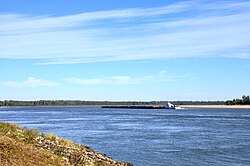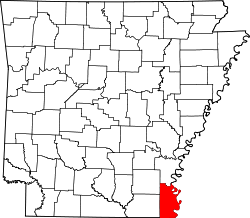History
Eunice was the eastern terminus of the Mississippi, Ouachita and Red River Railroad, the first railroad chartered in Arkansas. Construction of the line began in 1852, and by the start of the Civil War, 7 mi (11 km) of track had been laid west from Eunice. [2] The railroad was completed after the war, but was abandoned in 1875 after flooding on the Mississippi River damaged the railbed and bridges. [3]
Arkansas Highway 208 between Eunice and Halley was built on top of the abandoned railbed.
Civil War
On June 14, 1863, Confederate rebels at Eunice fired artillery onto the Union gunboat USS Marmora. The Marmora returned fire, and then anchored at Eunice. The next morning, the union gunboat Nebraska was fired upon as it approached Eunice. Both the Marmora and Nebraska bombarded the town with artillery, and then sent a party ashore. The soldiers set fire to stores, houses, and the railroad depot, destroying the town. The commander of the Marmora reported: "not a single vestige of the town of Eunice remains". [4] : 126
No rebels were found. [4]
This page is based on this
Wikipedia article Text is available under the
CC BY-SA 4.0 license; additional terms may apply.
Images, videos and audio are available under their respective licenses.



